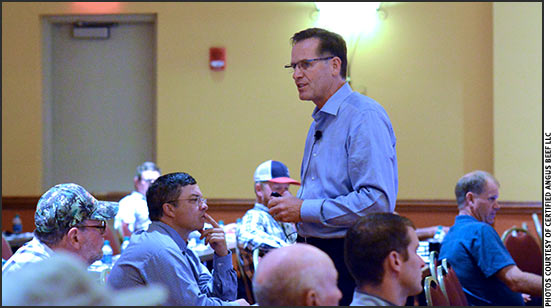
Ag Prospects Looking Up
Slow but sure improvement in rural economy.
It might not feel like a quick ascent, but agriculture will climb out of the slump affecting nearly all sectors in recent years.
That ray of hope comes from AgResource Co. President Dan Basse, who in August spoke as part of the Feeding Quality Forum in Omaha, Neb., while colleague Ben Buckner addressed the crowd with a similar message in Garden City, Kan.
“Dairy is the only industry this year that will make more gross than the year before,” Basse said, noting it is up $40 billion, compared to the beef sector, which will drop $7 or $8 billion.

“The United States will be a net exporter of crude oil by 2019,” said AgResource Co. President Dan Basse during August’s Feeding Quality Forum in Omaha, Neb. “This is a really big deal. [It’s] the first time we’ve had a net export of energy going back to the 1940s.”
“Our revenues have fallen in half. Name me another industry where net revenues have declined by 50% in a period of five years. That’s our story,” he said.
Cyclical trends and export prospects provide a glimmer.
“The world economies are improving at a pace faster than the U.S., but it is improving,” Buckner said. A surprising boon? “The best that’s happened in the last six months or so is the political chaos in Washington, D.C.”
Government instability has caused a decrease in the value of the U.S. dollar, a positive to agriculture since it relies heavily on exports, he said.
“That is putting pressure on producers overseas,” Basse said.
All commodities have a bit of good news in store.
“The United States will be a net exporter of crude oil by 2019,” Basse said. “This is a really big deal. [It’s] the first time we’ve had a net export of energy going back to the 1940s.”
The ethanol industry is starting to ramp up production, adding about a billion gallons of capacity to meet export demand.
“It’s part of the reason I think you all in the cattle business need to be looking in the next few weeks of taking some feed-need coverage over the next nine months,” he said.
Both analysts said it is unlikely corn markets will go more bearish coming into harvest. They suggested USDA’s corn yield estimate of 169.5 bushels (bu.) per acre is high, because the equation overestimates corn ear weight, given the dry conditions in much of the upper Midwest.
“We don’t think there’ll be a disaster; we just don’t think ear weight’s going to be this high,” Buckner said, noting a change from 169.5 bu. per acre to 167 or 165 can cut many millions of bushels off the total harvest.
“It doesn’t get you exceedingly bullish on corn, but it does tell me that if corn makes it down to $3.45 to $3.35, I would definitely want to be a buyer down in that area,” Basse said.
Longer-term, they expect a price increase. World stocks will decline over the next few years, but the United States will face increasing global competition as other countries make bigger improvements in yields.
“The U.S. farmer is the very best. It’s hard to really add yield nationwide when you’re yielding 168, 175 [bu. per acre],” Buckner said. Countries like Ukraine could increase 30% and Brazil by 50%, while the United States might reach a 4% improvement.
Competition is still a factor in the beef sector, but it relies less heavily on global markets, they said.
“Quarterly domestic use is really good, and this is the demand pull that I see in the beef market,” Basse said. “The quarterly per capita disappearance is now the largest it’s been since 2008.”
If trade with China really ramps up, Basse said, “I could get really bullish on the demand side of cattle sometime during the first quarter of next year.”

“We don’t think there’ll be a disaster; we just don’t think ear weight’s going to be this high,” said Ben Buckner of AgResource Co. referring to the national corn harvest. A change from 169.5 bu. per acre to 167 or 165 can cut many millions of bushels off the total harvest.
He doesn’t expect China to lift any requirements on U.S. beef.
“They like to have a lever on trade,” he said, but it probably also represents an overarching trend in food production. “I think that’s the way agriculture is going, in terms of producing what the market is demanding. I don’t think that’s all bad, because it gives consumers choice.”
However, before that trade can bolster the market, the larger beef harvest numbers in recent months and earlier-than-usual placements due to drought will continue to pressure prices in the fourth quarter.
AgResource predicts a bottom of $100-$104 per hundredweight (cwt.) for fed-cattle prices.
“I do believe we’ll see good exports again going forward,” Basse said. “The price structure of cattle has done its job in terms of building the demand down the road.”
Other hurdles remain. Ag lending is down, and competing proteins continue to expand. Pork production will increase by 2%-3% in 2018, Basse said: “Look over your shoulder, because there’s going to be plenty of pork on the doorstep of the United States.”
Things are looking up, but it may take a few years to feel across-the-board recovery.
“The markets are an ocean freighter, slow to move,” Buckner said. “We’re starting to steer them in the right direction and perhaps we are through the trough of this bear.”
The meetings, co-sponsored by Zoetis, Roto-Mix, IMI Global, Micronutrients, Feedlot magazine and Certified Angus Beef LLC, drew cattle feeders and allied industry from Nebraska, Kansas and several surrounding states.

Editor’s Note: Miranda Reiman is director of producer communications for Certified Angus Beef LLC.






